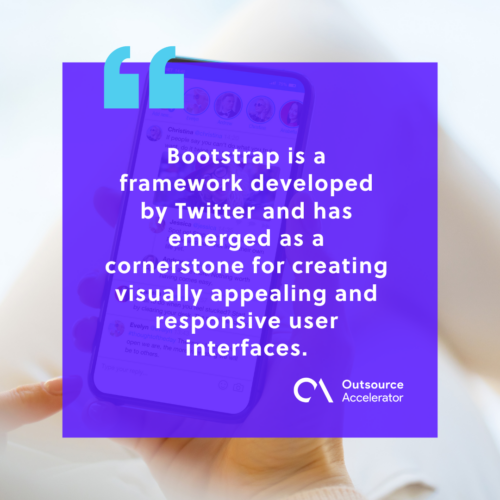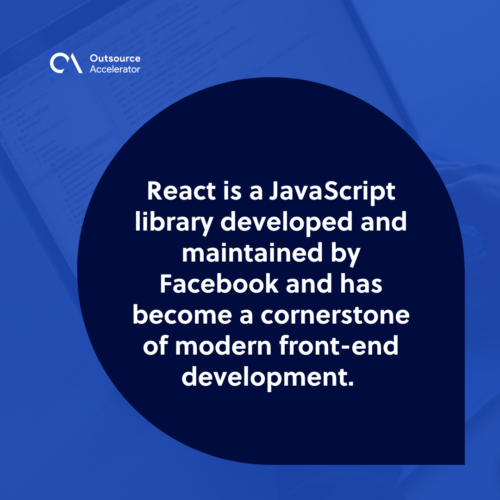Bootstrap vs. React: Which front-end framework works best?

Front-end development has evolved into a dynamic and intricate field, constantly adapting to the ever-changing landscape of web technologies and user expectations.
In the early days of the internet, front-end development primarily involved static HTML pages with minimal interactivity. Cascading Style Sheets (CSS) were introduced to separate the presentation layer from the content, allowing developers to apply styling independently.
However, as the demand for richer user experience (UX) grew, developers faced the challenge of creating responsive layouts, interactive elements, and consistent designs.
Fast forward to the modern digital world, the demand for more efficient and robust front-end solutions led to the emergence of various frameworks. Among these, Bootstrap and React have stood out as prominent players.
When choosing between Bootstrap vs. React, not that each framework offers a distinct approach to addressing the challenges of modern web development.
Bootstrap vs. React: What is a Bootstrap?
Bootstrap is a framework developed by Twitter and has emerged as a cornerstone for creating visually appealing and responsive user interfaces.
This widely-used front-end framework has redefined the way developers approach design and development. It is also a toolkit streamlining and accelerating web development by offering a comprehensive collection of pre-designed HTML, CSS, and JavaScript components.

Core components of Bootstrap
Bootstrap’s appeal lies in its robust core components, each meticulously designed to simplify the creation of modern web interfaces.
Here are the following components of the Bootstrap framework:
Grid system
Bootstrap’s grid system is a flexible framework that allows developers to structure their layouts easily. This system empowers developers to create intricate designs that fluidly adjust to the dimensions of different devices.
The grid system operates on a 12-column layout, enabling developers to allocate proportions of the screen width to different elements.
This modularity and adaptability simplify layout creation and contribute to a consistent user experience across devices.
Typography and styling
Consistency in typography and styling is key to a professional and visually harmonious web presence. Bootstrap addresses this by offering a comprehensive set of typography styles and CSS classes.
These styles are designed to work seamlessly with Bootstrap’s components, ensuring that fonts, colors, and text sizes remain consistent throughout the website.
Its consistency in styling extends to buttons, forms, and other UI components, creating an aesthetically pleasing and user-friendly environment.
Navigation and dropdowns
Navigational elements are the backbone of UX, allowing visitors to navigate the website’s content effortlessly. Bootstrap simplifies the creation of navigation bars and dropdown menus with its pre-built components.
These components are not only customizable in terms of appearance but also designed to integrate with other Bootstrap elements seamlessly.
Developers can implement navigation bars that adapt to various screen sizes and transform them into collapsible menus on smaller devices.
Forms and buttons
Forms and buttons are integral components of interactive websites, but designing them from scratch can be time-consuming.
Bootstrap’s collection of form controls and button styles alleviates this challenge, saving developers valuable time and effort. These button styles ensure that calls to action and interactive elements are visually appealing and consistent with the overall design.
Pros and cons of Bootstrap
The table below lists down the pros and cons of the Bootstrap framework:
| Pros | Cons |
| Rapid development using pre-built components | Generic appearance across websites |
| Responsive grid system for various devices | Heavier file size due to bundled components |
| Consistent styling and typography | Customization limitations on intricate designs |
| Well-documented with a large user community | Learning curve for beginners not familiar with CSS |
Bootstrap vs. React: What is a React?
React is a JavaScript library developed and maintained by Facebook and has become a cornerstone of modern front-end development. Its primary purpose is to simplify building user interfaces by providing powerful tools and concepts.
Unlike traditional libraries or frameworks, React focuses on a component-based architecture that enhances code reusability, maintainability, and performance.

Core components of React
React’s component-based approach enables teams to work collaboratively, with each member focusing on developing and maintaining specific components.
Here are the components of the React framework:
Components and JSX
These two components of React are self-contained, reusable building blocks that encapsulate both the visual elements and the underlying logic of a user interface.
The components allow developers to break down complex UIs into manageable pieces, making development more organized and efficient.
Meanwhile, JSX (JavaScript XML) is a unique syntax extension introduced by React. It allows developers to write UI components using a syntax resembling HTML.
This combination of JavaScript logic and HTML-like markup enhances the readability of the code and provides a more intuitive way to define the structure and appearance of components.
State and props
React introduces the concepts of “state” and “props” to manage data flow within components.
The state represents the internal data that can change over time within a component. For instance, in a counter component (a number that can be increased or decreased), the current count value would be stored in the component’s state.
By managing the state via props, React ensures that the UI updates in response to data changes without manually manipulating the DOM.
React hooks
React’s hooks simplify code organization, reduce unnecessary re-renders, and make it easier to reason about the behavior of components.
Hooks like useState, useEffect, useContext, and more allow developers to manage stateful logic and side effects within functional components directly.
The useState hook lets components maintain and update their state without needing class-based state management. On the other hand, the useEffect hook handles side effects such as data fetching, DOM manipulation, or subscriptions.
Pros and cons of React
The table below shows the pros and cons of the React framework:
| Pros | Cons |
| Component reusability and modularity | Complex learning curve, especially for beginners |
| Virtual DOM for optimized rendering | Requires additional tools/libraries for routing |
| Robust ecosystem and active community | May lead to performance issues if not optimized |
| Efficient state management with React hooks | JSX might seem unusual to developers familiar with HTML/CSS |
Bootstrap vs. React: Comparing both frameworks
Bootstrap vs. React, what’s in it for you? Let’s compare both frameworks with the following factors:
| Bootstrap vs. React: Comparison based on the characteristics | ||
| Characteristics | Bootstrap | React |
| File size and loading times | Larger file size due to bundled components | Smaller file size, optimized loading |
| Learning curve and community support | Gentle learning curve, extensive community | Moderate learning curve, strong community |
| Integration with back-end technologies | Versatile with various server-side tech | Compatible with JavaScript-based stacks |
| Project scalability and extensibility | Better suited for rapid development | Component-based structure for scalability |
Bootstrap vs. React: When to use the right framework
The choice between Bootstrap vs. React depends on the nature of your project and your team’s expertise.
You may choose Bootstrap if you need to prototype a simple website with consistent styling quickly. Or you may opt for React when building interactive and dynamic web applications that require efficient state management and reusability.
By considering factors such as project requirements, team skillsets, and desired features, you can make a well-versed decision that aligns with your development goals.







 Independent
Independent




